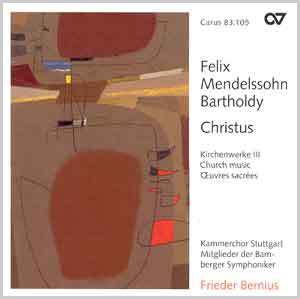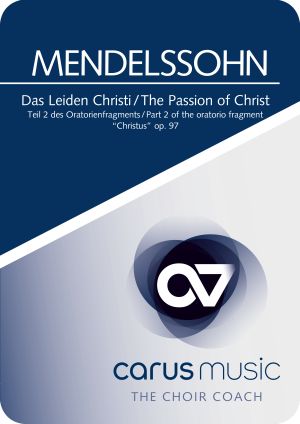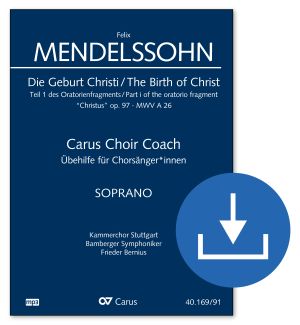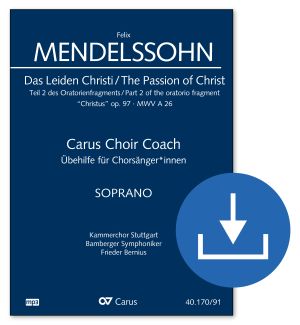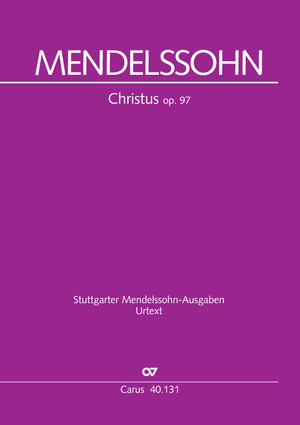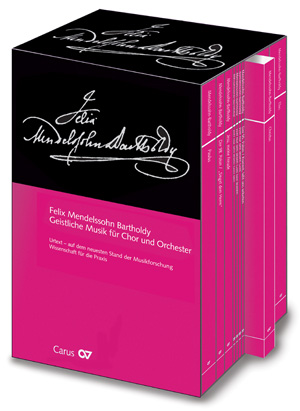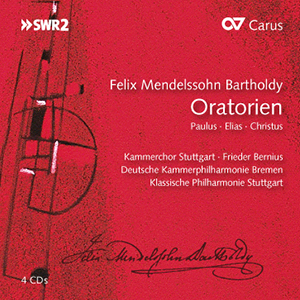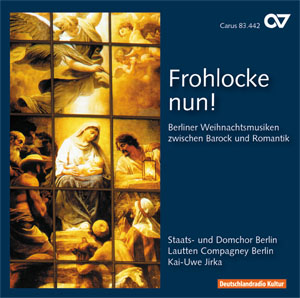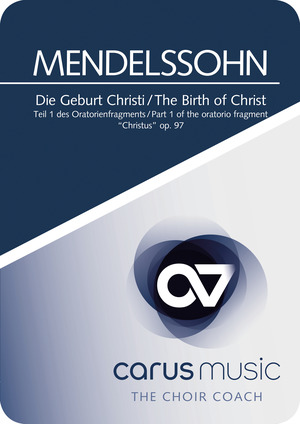
Le Christ
Fragment d’oratorio. Partie I: La Naissance du Christ; Partie II: Les Souffrances du Christ MWV A 26 (Op. 97), 1847
Die Geburt Christi (Naissance du Christ) et Das Leiden Christi (Passion du Christ) sont deux fragments d’un oratorio que Mendelssohn n’a pas réussi à terminer. Die Geburt Christi se concentre sur un chœur divisé en quatre sections et introduit par deux brèves parties solos. Ce chœur dégage une grande tension et associe des mouvements très différents. Pour mettre en valeur le début doux et fluide et le caractère dramatique de la deuxième partie ("und wird zerschmettern Fürsten und Städte"), chaque note des choristes doit être juste.
Il suffit de s'exercer. Partout. A tout moment.
Que ce soit à la maison sur votre tablette ou votre PC ou en déplacement sur votre smartphone : avec carus music, the Choir Coach, vous avez toujours vos œuvres chorales avec vous pour vous entraîner ! Avec l'application chorale de carus music, vous pouvez écouter votre partition ainsi qu'un enregistrement de première qualité sur n'importe quel appareil et vous entraîner facilement à votre propre partie de chœur avec un coach. Avec carus music, la préparation de vos concerts est facile, efficace et amusante à maîtriser !
Interprètes: Dorothea Rieger (soprano), Monika Meier-Schmid (soprano), Isolde Assenheimer (alto), Mechthild Seitz (alto), Stephan Dürr (tenore), Bernhard Scheffel (tenore), Johannes Happel (baritone), Cornelius Hauptmann (basso), Adolph Seidel (basso) – Kammerchor Stuttgart, Bamberger Symphoniker – Frieder Bernius
Sommaire
-
Compositeur
Felix Mendelssohn Bartholdy
| 1809-1847
-
Chœur
Kammerchor Stuttgart
The Kammerchor Stuttgart is regarded as one of the best ensembles of its kind. Over its fifty-year existence, Frieder Bernius has developed the choir into an exceptional ensemble acclaimed by audiences and press alike. This has led to invitations for the choir to perform at all the important European festivals. In Germany the chamber choir performs at festivals and in concert halls in repertoire ranging from the 17th to the 21st century. Frieder Bernius and his ensemble have received numerous accolades for their contribution to new music. The Kammerchor Stuttgart has made over 80 CDs and LPs, numerous of which have been awarded international recording prizes (including the Edison award, Diapason d’or, Gramophone Choice, Classical Internet Award, International Classical Music Award, and German Record Critics’ Award prizes). The International Federation for Choral Music has invited the ensemble to sing at the 1st, 4th and 10th World Symposia on Choral Music in Vienna, Sydney and Seoul. Regular tours of North America and Asia since 1988 and a South America tour reflect the Kammerchor Stuttgart’s international reputation. Since 1984 the top ensemble has also been invited to Israel biennially. Plus d'information sur la personne
-
Chef d'orchestre
Frieder Bernius
| 1947Frieder Bernius’s work has earned great worldwide recognition. He is in demand internationally as a conductor and as a teacher. His principal artistic collaborators are the ensembles he founded himself, the Kammerchor Stuttgart, the Barockorchester Stuttgart, the Hofkapelle Stuttgart and the Klassische Philharmonie Stuttgart. As a guest conductor, he has collaborated repeatedly with, for example, the SWR Vokalensemble Stuttgart, the Deutsche Kammerphilharmonie Bremen, the Stuttgarter Kammerorchester and the Streicherakademie Bozen. Great stylistic versatility is Frieder Bernius’s hallmark. Whether he conducts vocal works by Monteverdi, Bach, Händel, Mozart, Beethoven, Fauré and Ligeti, stage music by Mendelssohn or symphonies by Haydn, Burgmüller and Schubert, his work always aims for a sound that is at once unmistakably personal and at the same time oriented towards the original period sound ideal. He devotes himself equally to the rediscovery of 18th century operas and to first performances of contemporary compositions. He is particularly interested in the musical history of southwestern Germany. Carus-Verlag has awarded Frieder Bernius a Golden CD for his complete recording of the sacred music of Felix Mendelssohn Bartholdy. The award was presented to him during the German Choir Festival in Stuttgart 2016. The sale of over 250,000 recordings, which has been acclaimed with a number of awards, has made a not insignificant contribution to what today is the obvious presence of Mendelssohn's complete œuvre in the concert repertoire. Plus d'information sur la personne
-
Solist - soprano
Monika Meier-Schmid
-
Solist - alto
Isolde Assenheimer
-
Solist - alto
Mechthild Seitz
-
Solist - ténor
Christoph Prégardien
Christoph Prégardien a commencé sa carrière musicale comme enfant de chœur de cathédrale. Il est considéré aujourd’hui comme l’un des plus grands ténors lyriques de notre époque et travaille avec des chefs tels que Barenboim, Gardiner, Harnoncourt, Herreweghe, Nagano et Thielemann. A son répertoire, les grands oratorios et passions des époques baroque, classique et romantique, mais aussi des œuvres des 17ème au 20ème siècles. En dehors de son activité dans le domaine de l’opéra – en 2005, il a chanté par exemple le rôle-titre dans La Clemenza di Tito de Mozart à l’Opéra National de Paris – Prégardien est un interprète de lied reconnu. Parmi ses plus de 120 enregistrements maintes fois récompensés, mentionnons ses derniers CDs avec des lieder de Schumann, Wolf et Mahler, accompagné au piano par Michael Gees. De 2000 à 2005, Prégardien a dirigé une classe au Conservatoire de musique et de théâtre de Zurich, depuis 2004, il est professeur au Conservatoire de musique de Cologne. Dans une combinaison DVD-livre, il présente pour la première fois des questions de technique vocale et d’interprétation en paroles, images et son avec ses meilleurs élèves. Plus d'information sur la personne
-
Solist - ténor
Bernhard Scheffel
-
solist - baryton
Johannes Happel
-
Solist - basse
Adolph Seidel
Adolph Seidel a étudié le chant avec Peter Wetzler et Paul Lohmann. La musique du baroque ancien et moyen est l’un des points principaux de son travail. A côté des parties de basse de son activité de concertiste, il se consacre avec grand enthousiasme au chant choral. Ainsi, il est membre du Kammerchor Stuttgart depuis 1977, des Sechzehn Solisten du Kammerchor Stuttgart sous la direction de Frieder Bernius et du KammerChor Saarbrücken, et il a travaillé pendant plusieurs années comme basse attitrée de l’ensemble Orlando di Lasso. En plus de son activité de chanteur, il se consacre, en tant que directeur de l’ensemble vocal VocArt, à la musique vocale baroque, du petit effectif soliste aux oratorios. Plus d'information sur la personne
Questions fréquentes sur l'œuvre
 Il n'y a pas encore de questions et réponses concernant cette œuvre ou vous n'avez pas trouvé la réponse à votre question sur l'œuvre ? Cliquez ici et envoyez votre question spécifique à notre service clients.
Il n'y a pas encore de questions et réponses concernant cette œuvre ou vous n'avez pas trouvé la réponse à votre question sur l'œuvre ? Cliquez ici et envoyez votre question spécifique à notre service clients.


